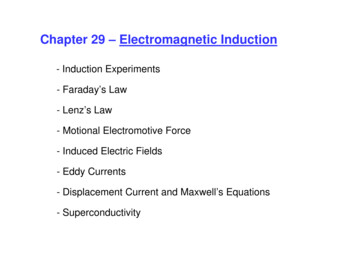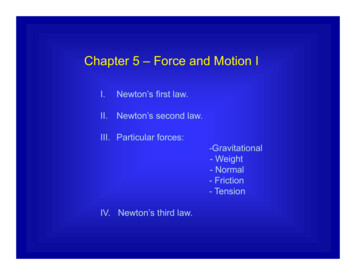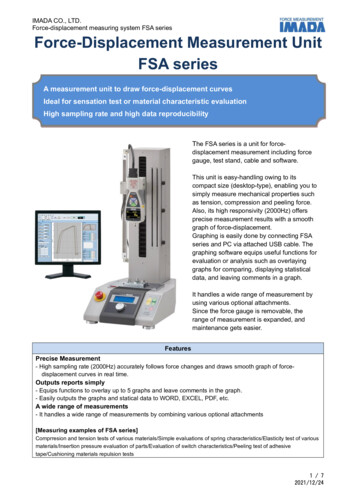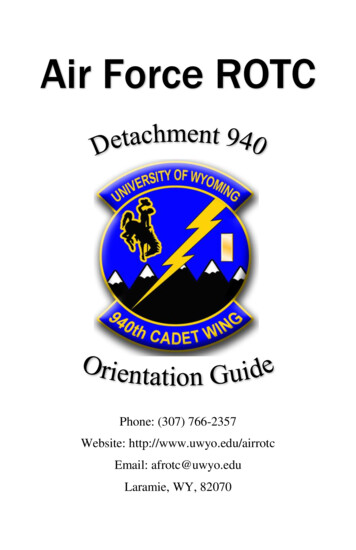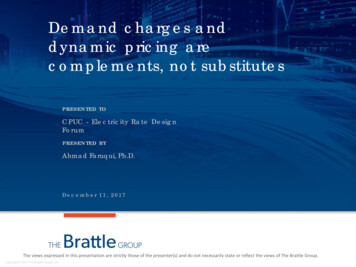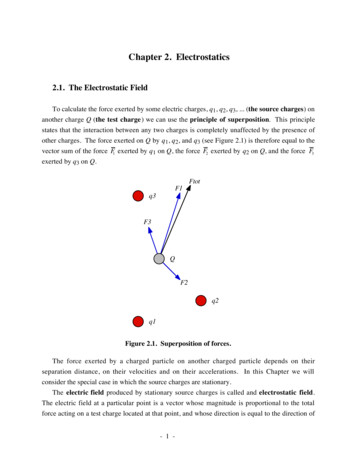
Transcription
MasteringPhysics: Assignment Print nmentPrint?assig.[ Assignment View ][Eðlisfræði 2, vor 200727. Magnetic Field and Magnetic ForcesAssignment is due at 2:00am on Wednesday, February 28, 2007Credit for problems submitted late will decrease to 0% after the deadline has passed.The wrong answer penalty is 2% per part. Multiple choice questions are penalized as described in the online help.The unopened hint bonus is 2% per part.You are allowed 4 attempts per answer.Forces on moving charges and currents in Magnetic FieldForce on Moving Charges in a Magnetic FieldLearning Goal: To understand the force on a charge moving in a magnetic field.Magnets exert forces on other magnets even though they are separated by some distance. Usually the force on amagnet (or piece of magnetized matter) is pictured as the interaction of that magnet with the magnetic field at itslocation (the field being generated by other magnets or currents). More fundamentally, the force arises from theinteraction of individual moving charges within a magnet with the local magnetic field. This force is written, where is the force, is the individual charge (which can be negative), is its velocity, and is thelocal magnetic field.This force is nonintuitive, as it involves the vector product (or cross product) of the vectors and . In thefollowing questions we assume that the coordinate system being used has the conventional arrangement of the axes,such that it satisfies, where , , and are the unit vectors along the respective axes.Let's go through the right-hand rule. Starting with the generic vector cross-product equationpoint yourforefinger of your right hand in the direction of , and point your middle finger in the direction of . Your thumbwill then be pointing in the direction of .Part AConsider the specific example of a positive charge moving in the x direction with the local magnetic field inthe y direction. In which direction is the magnetic force acting on the particle?Express your answer using unit vectors (e.g.,ANSWER:Direction of- ). (Recall thatis written x u n i t . ) Part BNow consider the example of a positive charge moving in the x direction with the local magnetic field in the z direction. In which direction is the magnetic force acting on the particle?Express your answer using unit vectors.ANSWER:Direction of Part C1 of 1317/4/07 16:06
MasteringPhysics: Assignment Print nmentPrint?assig.Now consider the example of a positive charge moving in the xy plane with velocity(i.e.,with magnitude at angle with respect to the x axis). If the local magnetic field is in the z direction, what isthe direction of the magnetic force acting on the particle?Hint C.1 Finding the cross productThe direction can be found by any of the usual means of finding the cross product:1. Use the determinant expression for the cross product. (See your math or physics text.)2. Use the general definition,where any term with the three directions in the normal order of xyz or any cyclical permutation (e.g., yzx orzxy) has a positive sign, and terms with the other order (xzy, zyx, or yxz) have a negative sign.Express the direction of the force in terms of , as a linear combination of unit vectors,, and .ANSWER:Direction of, Part DFirst find the magnitude of the force on a positive charge in the case that the velocitythe magnetic field (of magnitude ) are perpendicular.Express your answer in terms of , ,statement.ANSWER:(of magnitude ) and, and other quantities given in the problem Part ENow consider the example of a positive charge moving in the -z direction with speed with the local magneticfield of magnitude in the z direction. Find , the magnitude of the magnetic force acting on the particle.Express your answer in terms of , ,statement.ANSWER:, and other quantities given in the problem 0There is no magnetic force on a charge moving parallel or antiparallel to the magnetic field. Equivalently, themagnetic force is proportional to the component of velocity perpendicular to the magnetic field.Part FNow consider the case in which the positive charge is moving in the yz plane with a speed at an angle withthe z axis as shown (with the magnetic field still in the z direction with magnitude ). Find the magnetic forceon the charge.2 of 1317/4/07 16:06
MasteringPhysics: Assignment Print nmentPrint?assig.Part F.1 Direction of forcePart not displayedPart F.2 Relevant component of velocityPart not displayedExpress the magnetic force in terms of given variables like , ,ANSWER:, , and unit vectors. Electromagnetic Velocity FilterWhen a particle with charge moves across a magnetic field of magnitude , it experiences a force to the side. Ifthe proper electric field is simultaneously applied, the electric force on the charge will be in such a direction as tocancel the magnetic force with the result that the particle will travel in a straight line. The balancing conditionprovides a relationship involving the velocity of the particle. In this problem you will figure out how to arrangethe fields to create this balance and then determine this relationship.Part AConsider the arrangement of ion source and electric field plates shown in the figure. The ion source sends particleswith velocity along the positive x axis. They encounter electric field platesspaced a distance apart that generate a uniform electric field of magnitudein the y direction. To cancel the resulting electric force with a magneticforce, a magnetic field (not shown) must be added in which direction? Usingthe right-hand rule, you can see that the positive z axis is directed out of thescreen.Hint A.1 Method for determining directionHint not displayedHint A.2 Right-hand ruleHint not displayedChoose the direction of.ANSWER: Answer not displayedPart BPart not displayedPart CPart not displayedA Conductor Moving in a Magnetic FieldA metal cube with sides of length is moving at velocityacross a uniform magnetic field. The cube isoriented so that four of its edges are parallel to its direction of motion (i.e., the normal vector of two faces areparallel to the direction of motion).3 of 1317/4/07 16:06
MasteringPhysics: Assignment Print nmentPrint?assig.Part AFind , the electric field inside the cube.Hint A.1 Net force on charges in a conductorElectrons in a conductor are more or less free to move within the conductor. As a result electrons in a conductorplaced in an electric field (with no magnetic field present) will move until the electic field that they generateinside the conductor cancels the applied field (i.e., until the net internal electric field equals zero). In general, thecharges in a conductor move until the net force on them is zero. This happens almost instantaneously in a goodconductor.In this problem, there is no external electric field but there is a force on the electrons due to the applied magneticfield. The electrons will thus move in such a way as to create an electric field that will cancel the magnetic forceon them (leaving a net force of zero on the electrons).Part A.2 Find the magnetic force magnitudeWhat iscube?, the magnitude of the force due to the magnetic field exerted on an electron with chargeExpress your answer in terms of some or all of the variables ,ANSWER:, andinside the. Part A.3 Find the magnetic force directionUse the vector equationfield. Remember to useand the right-hand rule to determine the direction of the force from the magneticfor the electron charge.Answer in terms of the unit vectors, , and .ANSWER:Part A.4 Determine the force due to the electric fieldWhat is, the force on an electron inside the cube with chargedue to an induced electric field ?Express your answer in terms of one or both of the variablesANSWER: Express the electric field in terms ofANSWER:and .,, and unit vectors ( , , and/or ) . Now, instead of electrons, suppose that the free charges have positive charge . Examples include "holes" insemiconductors and positive ions in liquids, each of which act as "conductors" for their free charges.Part BIf one replaces the conducting cube with one that has positive charge carriers, in what direction does the inducedelectric field point?4 of 1317/4/07 16:06
MasteringPhysics: Assignment Print nmentPrint?assig.ANSWER:The direction of the electric field stays the same regardless of the sign of the charges that are free to move in theconductor.Mathematically, you can see that this must be true since the expression you derived for the electric field isindependent of .Physically, this is because the force due to the magnetic field changes sign as well and causes positive chargesto move in thedirection (as opposed to pushing negative charges in thedirection). Therefore the resultis always the same: positive charges on theside and negative charges on theside. Because the electricfield goes from positive to negative charges will always point in thedirection (given the originaldirections ofand ).Rail GunA Rail Gun uses electromagnetic forces to accelerate a projectile to very high velocities. The basic mechanism ofacceleration is relatively simple and can be illustrated in the following example. A metal rod of mass andelectrical resistance rests on parallel horizontal rails (that have negligible electric resistance), which are a distanceapart. The rails are also connected to a voltage source , so a current loop is formed.The rod begins to move if the externally applied vertical magnetic field inwhich the rod is located reaches the value . Assume that the rod has a slightlyflattened bottom so that it slides instead of rolling. Use for the magnitude ofthe acceleration due to gravity.Part AFind , the coefficient of static friction between the rod and the rails.Hint A.1 How to approach this problemHint not displayedPart A.2 Force due to the magnetic fieldPart not displayedPart A.3 Frictional forcePart not displayedExpress the coefficient of static friction in terms of variables given in the introduction.ANSWER: Charge moving in Cyclotron Orbits5 of 1317/4/07 16:06
MasteringPhysics: Assignment Print nmentPrint?assig.Charge Moving in a Cyclotron OrbitLearning Goal: To understand why charged particles move in circles perpendicular to a magnetic field and whythe frequency is an invariant.A particle of charge and mass moves in a region of space where there is a uniform magnetic field(i.e., amagnetic field of magnitude in the z direction). In this problem, neglect any forces on the particle other thanthe magnetic force.Part AAt a given moment the particle is moving in the x direction (and the magnetic field is always in the zdirection). If is positive, what is the direction of the force on the particle due to the magnetic field?Hint A.1 The right-hand rule for magnetic forceHint not displayedANSWER: Answer not displayedPart BPart not displayedPart CPart not displayedPart DPart not displayedMotion of Electrons in a Magnetic FieldAn electron of massand chargeis moving through a uniform magnetic fieldorigin, it has velocity, whereperpendicular to the x axis at a distancein vacuum. At theand. A screen is mountedfrom the origin.Throughout, you can assume that the effect of gravity is negligible.Part AFirst, suppose. Find the y coordinate of the point at which the electron strikes the screen.Hint A.1 Forces acting on electronHint not displayedHint A.2 Two-dimensional kinematicsHint not displayed6 of 1317/4/07 16:06
MasteringPhysics: Assignment Print nmentPrint?assig.Part BNow suppose, and another electron is projected in the same manner. Which of the following is the mostaccurate qualitative description of the electron's motion once it enters the region of nonzero magnetic field?ANSWER: Answer not displayedPart CPart not displayedMass SpectrometerJ. J. Thomson is best known for his discoveries about the nature of cathode rays. Another important contributionof his was the invention, together with one of his students, of the mass spectrometer. The ratio of mass to(positive) charge of an ion may be accurately determined in a mass spectrometer. In essence, the spectrometerconsists of two regions: one that accelerates the ion through a potential and a second that measures its radius ofcurvature in a perpendicular magnetic field.The ion begins at potential and is accelerated toward zero potential. When theparticle exits the region with the electric field it will have obtained a speed .Part AWith what speed does the ion exit the acceleration region?Hint A.1 Suggested general methodPerhaps the easiest method to use for solving this problem is conservation of energy.Part A.2 Initial energyFind the initial total mechanical energyExpressANSWER:in terms of, ,(which includes electric potential energy) of the particle., and any constants. Part A.3 Final energyFind , the total mechanical energy of the ion as it exits the region with the electric field (i.e., when it reachesthe region of zero electric potential and enters the magnet).ExpressANSWER:in terms of, , and any needed constants. Find the speed in terms ofANSWER:, ,, and any constants. Part B7 of 1317/4/07 16:06
MasteringPhysics: Assignment Print nmentPrint?assig.After being accelerated, the particle enters a uniform magnetic field of strength and travels in a circle of radius(determined by observing where it hits on a screen--as shown in the figure). The results of this experiment allowone to findin terms of the experimentally measured quantities such as the particle radius, the magnetic field,and the applied voltage.What is?Part B.1 Cyclotron frequencyFind the cyclotron frequency , which is the (angular) frequency of the orbital motion of the ion in the magneticfield. There is a skill builder problem on this if you need help.Hint B.1.a General method to findHint not displayedExpress the cyclotron frequency in terms ofANSWER:andWhat is the relationship between the cyclotron frequencydefinition of angular speed.)ANSWER:. Part B.2 Relationship ofExpress, , andin terms ofand the kinematic variablesand ? (This is theand . Hint B.3 Putting it all togetherEliminate from the two equations from the previous hints, and then eliminateresult should givein terms of the experimentally measured parameters.ExpressANSWER:in terms of,,using the result of Part A. The, and any necessary constants. By sending atoms of various elements through a mass spectrometer, Thomson's student, Francis Aston,discovered that some elements actually contained atoms with several different masses. Atoms of the sameelement with different masses can only be explained by the existence of a third subatomic particle in addition toprotons and electrons: the neutron.Torques on Magnetic Dipoles in Uniform FieldTorque on a Current Loop in a Magnetic FieldLearning Goal: To understand the origin of the torque on a current loop due to the magnetic forces on thecurrent-carrying wires and to introduce the magnetic moment of the loop .This problem will show you how to calculate the torgue on a magnetic dipole in a uniform magnetic field. Westart with a rectangular current loop, the shape of which allows us to calculate the Lorentz forces explicitly. Thenwe generalize our result. Even if you already know the general formula to solve this problem, you might find itinstructive to discover where it comes from.Part AA current flows in a plane rectangular current loop with height and horizontal sides . The loop is placed into auniform magnetic field in such a way that the sides of length are perpendicular to , and there is an anglebetween the sides of length and .8 of 1317/4/07 16:06
MasteringPhysics: Assignment Print nmentPrint?assig.Calculate , the magnitude of the torqueabout the vertical axis of the current loopdue to the interaction of the currentthrough the loop with the magnetic field.Hint A.1 How to approach the problemFirst find the forces (direction and magnitude) on each segment of the loop. Then find the torque due to each forceand add them up.Part A.2 Forces on the parts of the loop that have lengthAs current is moving through the loop, forces act on its different parts. These result from Lorentz forces on thecharges that move through the wire. What is the direction of the forces on the two pieces of wire of length ?Hint A.2.a Force on a straight current-carrying wire in a magnetic fieldThe forceon a straight wire of length carrying current in a magnetic fieldis given by.Select the correct diagram from the four options. The forces are symbolized by the redarrows.ANSWER:A B CDThe forces on these parts of the loop don't cause a motion of the center of mass, since they are equal andopposite, but they do produce a net torque for general , since their lines of action do not pass through thecenter of mass of the loop.Part A.3 Force on a current-carrying wire in a magnetic fieldFind , the magnitude of the force on each of the vertical wires (those with length ).Hint A.3.a Relevant equationHint not displayedExpressin terms of , , , andANSWER:. Note that not all of these may appear in the answer. Part A.4 Torque on a loopFind , the component of the torque around the vertical axis of the loop (i.e., out of the plane of the top-viewfigure).Hint A.4.a Definition of torqueHint not displayedExpress9 of 13in terms of, , and .17/4/07 16:06
MasteringPhysics: Assignment Print t/assignmentPrint?assig. Part A.5 Forces on the parts of the loop that have lengthAs current is moving through the loop, forces act on its different parts. These result from Lorentz forces on thecharges that move through the wire. What can you say about the forces on the two pieces of wire of length ?Select the most accurate qualitative description from the following list.ANSWER:The forces point away from the center of the loop and cancel each other.The forces act as a torque about an axis through the midpoints of the two two pieces of lengthb and make the loop turn in the direction of positive .The forces point toward the center of the loop and cancel each other.Both forces point upward perpendicular to and .Since the forces on these two parts of the loop cancel out, and their line of action goes through the center ofmass of the loop, we need not consider them in the calculation of the torque on the loop. The key is that theforces are in line, so their torque contributions about any point cancel.Express the magnitude of the torque in terms of the given variables. You will need atrigonomeric function [e.g.,or]. Usefor the magnitude of the magnetic field.ANSWER: Part BGive a more general expression for the magnitude of the torque . Rewrite the answer found in Part A in terms ofthe magnitude of the magnetic dipole moment of the current loop . Define the angle between the vectorperpendicular to the plane of the coil and the magnetic field to be , noting that this angle is the complement ofangle in Part A.Hint B.1 Definition of the magnetic dipole momentHint not displayedGive your answer in terms of the magnetic momentANSWER:, magnetic field, and . The more general vector form of this expression is.Part CA current flows around a plane circular loop of radius , giving the loop a magnetic dipole moment of magnitude. The loop is placed in a uniform magnetic field , with an angle between the direction of the field lines andthe magnetic dipole moment as shown in the figure. Find an expression for the magnitude of the torque on thecurrent loop.10 of 1317/4/07 16:06
MasteringPhysics: Assignment Print nmentPrint?assig.Hint C.1 Formula for the area of a circleHint not displayedExpress the torque explicitly in terms of , , , , and(where and are the magnitudesof the respective vector quantities). Do not use . You will need a trigonomeric function[e.g.or].ANSWER: A DC MotorA shunt-wound DC motor with the field coils and rotor connected in parallel (see the figure) operates from a 115DC power line. The resistance of the field windings, , is 235 . Theresistance of the rotor, , is 6.00 . When the motor is running, the rotordevelops an emf . The motor draws a current of 4.08 from the line. Frictionlosses amount to 41.0 .Part ACompute the field current .Hint A.1 Voltages in a parallel circuitRecall that for each element in a parallel circuit there is the same voltage difference between the individualelements. As a result, the same voltage difference of 115 lies across both the field windings withresistance 235 and the rotor with resistance 6.00 .Hint A.2 Current through a resistorRecall that the current passing through an element with resistanceis given by,whereis the voltage across the resistor.Express your answer in amperes.ANSWER: 0.489Part BCompute the rotor current .Hint B.1 Currents in a parallel circuitRecall that for a circuit in parallel, there are multiple paths for the total current to take in getting from thepositive electrode of the power supply to the negative electrode. As a result, different amounts of current passthrough the elements in a parallel circuit according to the resistance and the voltage differences on each element.The current passing through each of the sections must add up to the total current being supplied by the powersupply.ANSWER:11 of 13 3.5917/4/07 16:06
MasteringPhysics: Assignment Print nmentPrint?assig.Part CCompute the emf .Hint C.1 How to approach the problemThink of the back emf from the rotor as reducing the voltage difference from the power supply across the rotor.You can picture the system diagrammatically by putting the resistance part of the rotor and the back emf part ofthe rotor in series. This gives you the equationfor total voltage across the rotor, where is the voltagefrom the power supply, is the voltage across the resistance element of the rotor, and is the back emf from therotor. We already know that, and we can find by using the current calculated in Part B.Hint C.2 Relation between voltage and currentHint not displayedANSWER: 93.5Part DCompute the rate of development of thermal energy in the field windings.Part D.1 Equation for thermal energyPart not displayedExpress your answer in watts.ANSWER: 56.3Part ECompute the rateof development of thermal energy in the rotor.Part E.1 Equation for thermal energyWhat is the power dissipated via heat through a resistor of resistancethat has a current of passing through it?ANSWER:Express your answer in watts.ANSWER: 77.4Part FCompute the power input to the motor.Part F.1 Equation for total power inputWhat is the power through an electric circuit of voltageand current ?ANSWER:12 of 1317/4/07 16:06
MasteringPhysics: Assignment Print nmentPrint?assig.Express your answer in watts.ANSWER: 469Part GCompute the efficiency of the motor.Hint G.1 Definition of efficiencyThe efficiency of an electrical motor (or any motor for that matter) is given by the ratio of the power coming outof the circuit, after all losses are taken into account, and the total power initially supplied to the circuit. Thisefficiency must be a value less than or equal to one, since the power coming out of the circuit must be less thanor equal to the power going in (i.e., the circuit cannot generate its own energy, but can only consume it).ANSWER:0.628Changing Energy of a Magnetic CoilA coil with magnetic moment 1.49magnetic field of magnitude 0.810 .is oriented initially with its magnetic moment antiparallel to a uniformPart AWhat is the change in potential energy of the coil when it is rotated 180 degrees, so that its magnetic moment isparallel to the field?Hint A.1 Potential energy for a magnetic dipoleHint not displayedHint A.2 Potential energy differenceHint not displayedHint A.3 Definition of antiparallelHint not displayedExpress your answer in joules.ANSWER:Summary13 of 13-2.417 of 10 problems complete (67.63% avg. score)33.82 of 35 points17/4/07 16:06
Consider the arrangement of ion source and electric field plates shown in the figure. The ion source sends particles with velocity along the positive x axis. They encounter electric field plates spaced a distance apart that generate a uniform electric field of magnitude in the y direction. To cancel the resulting electric force with a magnetic
